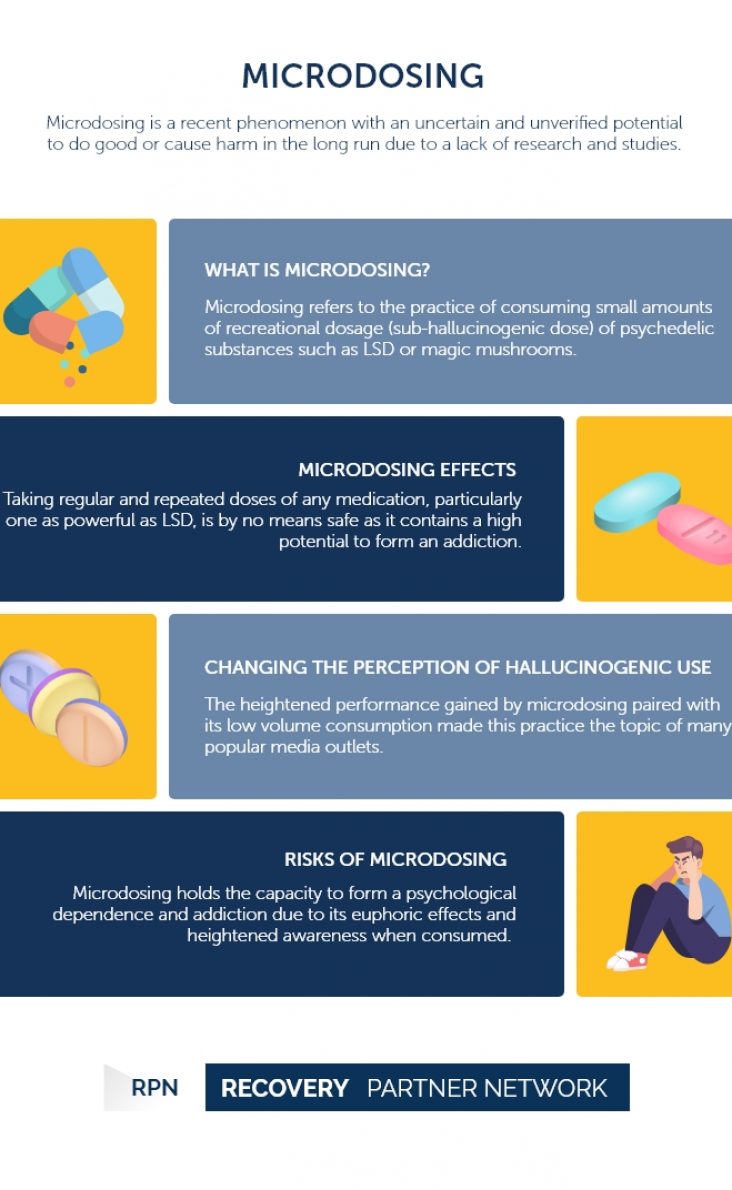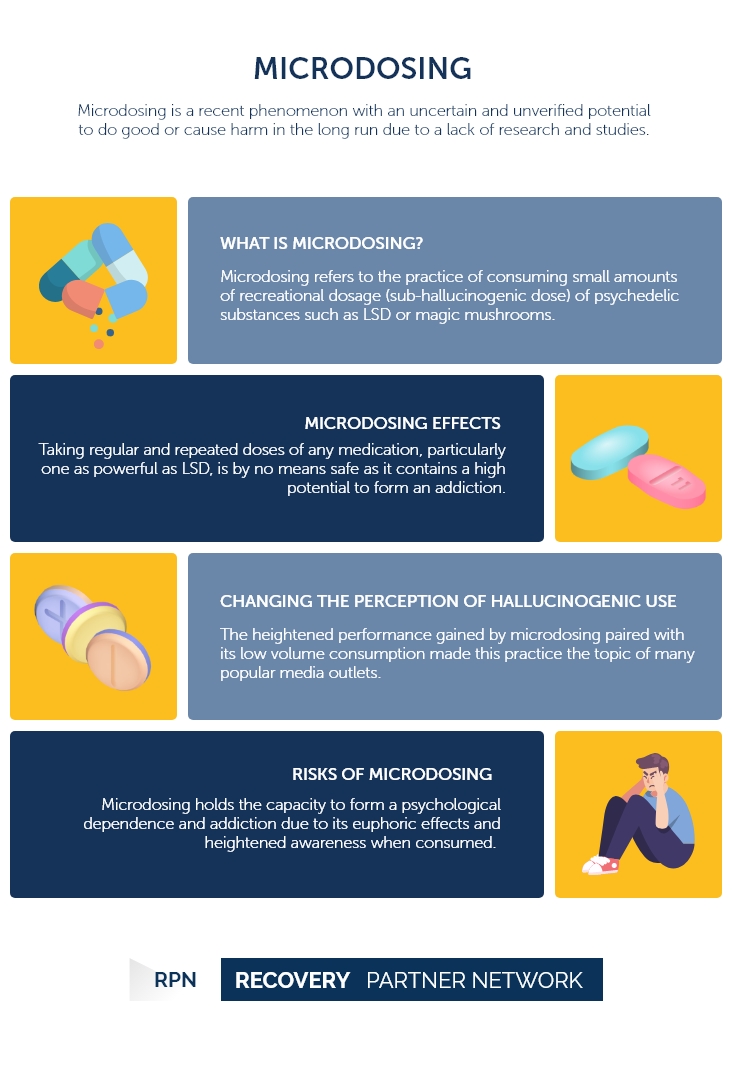Microdosing is a recent phenomenon with an uncertain and unverified potential to do good or cause harm in the long run due to a lack of research and studies.
Microdosing
Illicit drugs
- Ayahuasca addiction – Abuse
- Baclofen addiction
- Black tar heroin addiction
- Cannabis addiction
- Cocaine dependence
- Crack cocaine addiction
- DMT addiction abuse treatment
- Does Marijuana Kill Brain Cells?
- Ecstasy addiction
- Gabapentin addiction
- gamma-Hydroxybutyric acid addiction
- Hallucinogen
- Heroin addiction
- Illicit drug addiction
- Inhalant addiction
- Cocaine
- Ketamine addiction
- Lysergic acid diethylamide addiction
- Mescaline addiction
- Methamphetamine addiction
- Meth Labs: Cooking up Addiction
- Meth Mouth
- Microdosing
- Phencyclidine addiction
- Psilocybin mushroom addiction
- Sage of the diviners – Addiction
- Shooting Heroin
- Shooting Methamphetamine
- Smoking Cannabis
- Speedball
- Synthetic cannabinoids
Microdosing | Table of Contents
What is Microdosing?
Microdosing refers to the practice of consuming small amounts of recreational dosage (sub-hallucinogenic dose) of psychedelic substances such as LSD or magic mushrooms. Microdosing such psychedelic substances are claimed to enhance mood, cause mental and physical stimulation, and enhance creative thinking.
Although this practice has gained popularity over recent years, there are very few research and studies conducted under this topic. Microdosing LSD and other hallucinogens originally gained popularity among Silicon Valley engineers as it provided them hours of uninterrupted focus and concentration. Recently, this practice has been taken up by many millennials from all walks of life. The rapid widespread of this practice is highly influenced by the lack of studies on the drug’s adverse consequences and its public hype on its benefits.
FAQ
A microdose is one-tenth or one-twentieth of a typical recreational dose of a drug.
An individual should not practice microdosing if they have children in their care, have experienced trauma, feeling unwell, living on the autism spectrum, or colorblind. People with a history of psychotic disorders, such as bipolar disorder, schizophrenia, or other disorders, may also want to avoid microdosing, as the practice may be too stimulating.
Microdosing Effects
Emerging reports back the idea that hallucinogenic drugs,, administered in limited amounts or under the observation and direction of a licensed practitioner, can be used to address psychiatric conditions such as stress, PTSD, and anxiety. However, taking regular and repeated doses of any medication, particularly one as powerful as LSD, is by no means safe as it contains a high potential to form an addiction.
Most hallucinogenic drugs are classified as a Schedule I Substance under the Controlled Substance Act. Nonetheless, more and more people are now drawn towards the drug for its performance-enhancing effects. Testimonials of personal microdosers such as young tech workers, middle-aged parents, and even high-ranking business executives from prominent corporations can be found online on many sites devoted to content on microdosing. These reviews, though, do not come from medical or psychological practitioners and should not be followed. LSD and other psychedelics are harmful and unlawful and may cause significant medical, social, and legal problems.
Given the illegal classification of many hallucinogens, it is challenging to perform FDA-approved scientific studies. Most microdosing experiments currently available focus on the reporting and statistics given by self-proclaimed microdosers who are likely to have a favorable practice bias. Subsequently, legitimate and scientific research on the psychological effects of microdosing remains yet to be discovered.
FAQ
- What are the side effects associated with microdosing?
- How does microdosing affect those with depression?
- Is microdosing safe?
- Is there a difference between using psilocybin versus LSD for microdosing?
The side effects associated with microdosing are increased anxiety, reduced focus and energy, and uncomfortable sensations or feelings.
A survey indicates that microdosing has positively influenced about 80% of individuals with treatment-resistant depression. Unlike antidepressants, microdosing helps patients with depression experience more positive feelings.
Although the risks of consuming recreational doses of drugs are well studied and documented, there remains very little information on the long term risks associated with microdosing.
Research has not indicated a major difference between the two substances. However, some people have reported slight nausea with psilocybin, whereas that has not been noted with LSD.
Changing the Perception of Hallucinogenic Use
Microdosing gained its popularity within the Silicon Valley tech community between 2010 and 2013, partly due to its endorsement by LSD researcher, James Fadiman. The heightened performance gained by microdosing paired with its low volume consumption made this practice appealing and less scary to many. Usually referred to as the “smart drug” or “miracle drug,” the practice of microdosing in Silicon Valley has also been the topic of publications in many popular media outlets, like Forbes and Rolling Stones.. Despite the lack of scientific support, these claims rapidly transformed the practice from a niche hobby to a widespread habit that has greatly contributed towards the misuse and abuse of hallucinogenics. Although several authors have taken an optimistic tone about this trend, numerous medical and psychiatric experts have voiced concern over this subject.
Young college students and professionals have also shown keen interest in microdosing as a replacement for Adderall.. Due to the perceived benefits, many individuals who do not consider themselves a traditional drug consumer find themselves drawn to LSD microdosing.
Risks of Microdosing
There is a widespread belief that hallucinogenic substances are comparatively harmless since they are not as physically addictive as other drugs, such as opiates and benzodiazepines. However, it does hold a capacity to form a psychological dependence, as seen in any substance that is abused due to its euphoric effects and heightened awareness. The neurotransmitters responsible for producing such a positive association may put certain individuals at risk of developing a psychological addiction.
However, the major drawback of microdosing remains its uncertain and unverified long term effects of this practice. Current data on this subject is generated by collecting information online from microdosers without the ability to verify the accuracy of the information. These studies are largely unreliable, which leaves a large number of microdosers susceptible to any number of adverse consequences in the long run.
Certain stimulants with hallucinatory effects often pose possible dangers when microdosing due to its other characteristics that are generally not found in hallucinogens. Microdosing stimulants such as MDMA and ecstasy raise an individual’s chance of developing adverse health complications that could be fatal. Consuming any form of the illegal drug comes with its own risk as traffickers generally combine hallucinogens with other substances such as fentanyl, meth, or ketamine. These contaminants are not only extremely addictive but may induce a fatal overdose.
Microdose and Mental Disorders
There are many studies regarding psychedelics full-dose potential effects in managing psychiatric disorders such as depression, anxiety, PTSD, and as a treatment for alcohol and tobacco dependence. While full dose treatment shows great promise in treating chronic psychiatric conditions, it would be plausible to assume that psychedelics in low doses could also benefit patients with milder mental health conditions.
In 2018, two studies showed Psilocybin’s capacity to alleviate symptoms of treatment-resistant depression. The findings found little signs of adverse effects generally seen in traditional antidepressants, such as mood changes or apathy. Hallucinogens such as Ayahuasca, an Amazonian plant mixture of psychedelic properties, displayed positive outcomes during trials, and was considered as a safe and positive therapy for depression and alcoholism. Another research directly investigating the impact of LSD, Psilocybin, and mescaline showed that participants showed improved levels of creativity, concentration, satisfaction, and productivity. Although long-term effects have indicated a reduction in depression and anxiety symptoms, studies have also observed a rise in neuroticism and negative feelings in some patients.
The limited research on microdosing compared to full dose psychedelic treatment could prematurely overlook the potential outcomes significant to microdosing. Consequently making it risky for people to attempt microdosing independently. Consumption of any medication without a prescription is unsafe in general, but the uncertainty of this practice increases the risk exponentially.
Recovery Partner Network
We aim to educate and empower. If you feel our library of resources does not cover your specific need, reach out to us, and we would be happy to help.
STATISTICS
© Copyright 2025


